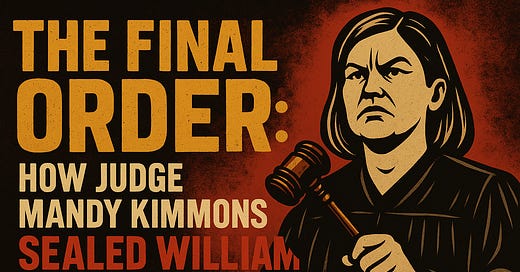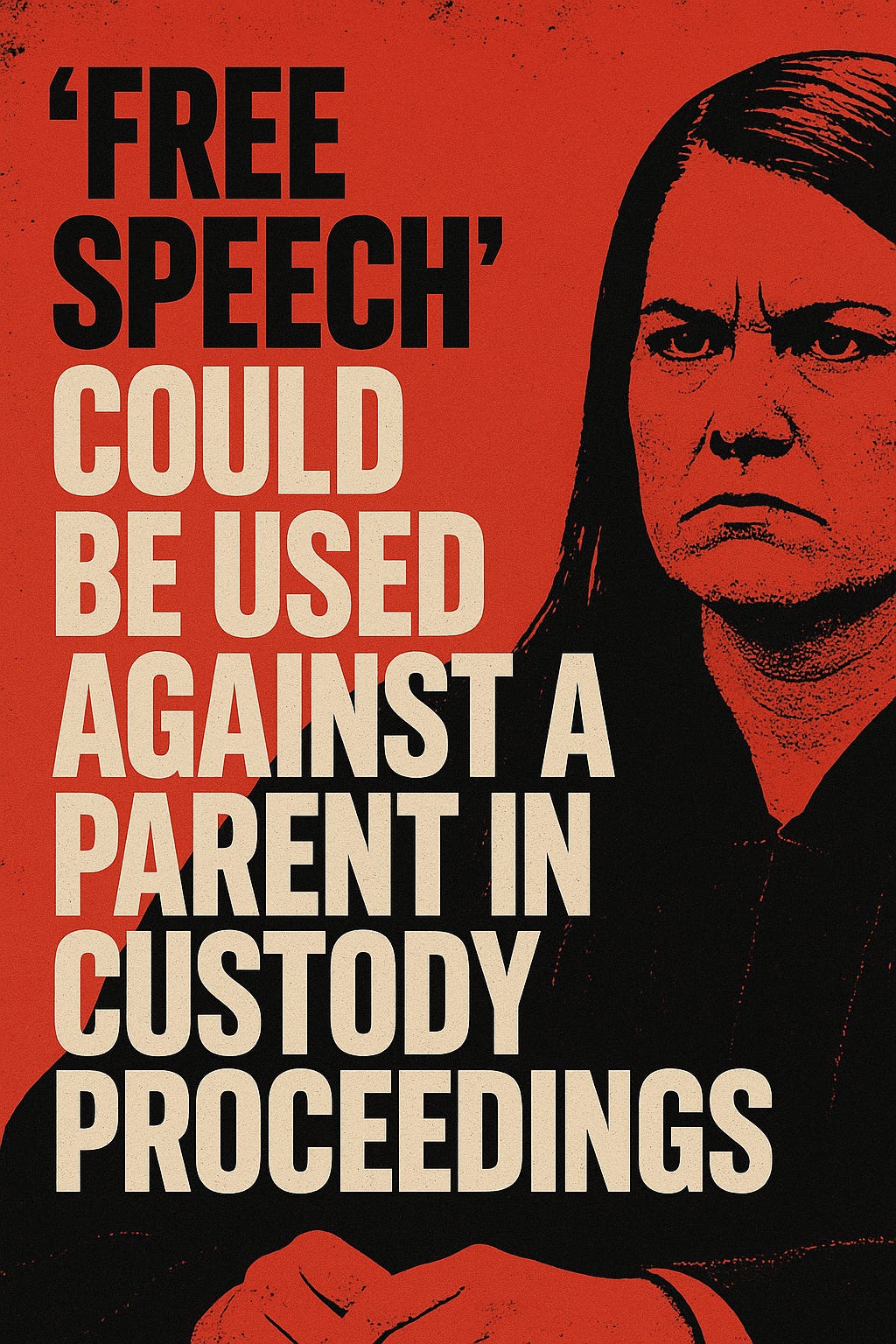The Final Order: How Judge Mandy Kimmons Sealed William Sewell’s Fate
And Turned Her Courtroom Into a Personal Pulpit of Power
INTRODUCTION
When the Final Order dropped on July 14, 2025, the case of Sewell v. Sewell didn’t end—it imploded. The ruling, signed by Judge Mandy Kimmons, reads not as the conclusion of a fair trial, but as the final act of a biased campaign to dismantle William Sewell’s life, silence his advocacy, and enrich the players who helped engineer his downfall—most notably, opposing counsel Donnie Gamache.
Thanks to testimony, court transcripts, and the deeply reported Thunder Report articles, including “From the Bench to the Bully Pulpit,” we now understand just how thoroughly the system failed. This wasn’t a custody case. This was a coordinated effort to erase a father’s rights while dressing the outcome in legal formalities.
1. A Judge with a Microphone, Not a Gavel
Courtroom as Stage
Judge Mandy Kimmons repeatedly stepped outside the bounds of judicial neutrality. She made reference to her public image, her previous career as a state lawmaker, and her dissatisfaction with how she was being portrayed by the press. According to The Thunder Report, she even warned William Sewell in open court that his media interviews were making her “look bad.”
These are not the actions of a neutral arbiter. They are the behaviors of a public figure attempting to manage personal reputation under the cover of judicial authority. In doing so, Kimmons erased the line between adjudication and retaliation.
Denial by Default
Kimmons denied all twelve of William’s pretrial and trial motions, including:
A motion under Turner v. Rogers requesting appointed counsel due to lack of representation
A motion for protective review citing judicial bias and retaliation
A motion to continue trial so William could retain an attorney
A motion challenging the legitimacy of service and procedural fairness
Each motion was rejected with boilerplate denials, often declaring them “wholly without merit.” No substantive reasoning. No due process discussion. No recognition of William’s pro se status or constitutional rights.
To make matters worse, the motions, though marked denied, are set to be heard at a hearing in August 2025. These were intended to be pre-trial motions for a pre-trial hearing that, by law, never took place.
2. Donnie Gamache, The Attorney Who Runs the Room
More Than Counsel
Donnie Gamache didn’t just represent Leslie Sewell—he dominated the courtroom dynamic. Campaign records reveal that Gamache was a past donor to Kimmons during her time in the legislature. His firm benefits from regular appearances in her courtroom. In this case, he didn’t just win—he controlled the tempo, tone, and tactics.
The Final Order reads as though it was drafted from Gamache’s litigation outline:
Sole custody for the Plaintiff
A forced sale or refinance of William’s premarital home
A $60,000 court-ordered payment from William to Gamache
No acknowledgment of William’s years of active fatherhood or legitimate legal claims
The $60,000 Extraction
The financial punishment wasn’t just disproportionate—it was strategic. The court ordered William to refinance or sell his house to pay Gamache directly. This isn’t just unusual—it’s punitive. It reflects not an effort to equalize resources or protect a child, but to break a litigant who dared to fight back publicly.
And make no mistake—these threats of financial penalties came well before William filed public complaints, spoke to media outlets, and brought attention to the political and financial entanglements surrounding this case. He acted out of fear from the threats that came from Donnie Gamache, Justin Wheeler, and Mandy Kimmons.
Any attempt by Kimmons to save face by claiming William Sewell was penalized for acting out is a farce. William was left with no way to protect himself in Kimmons' corrupt courtroom. No matter what happened, Kimmons was going to ensure that her friend Donnie Gamache got paid and hold an innocent father accountable for their own corrupt conduct.
3. The Child Was Never the Priority
Despite claiming to center the best interest of the child, the court’s order failed to engage in any serious best-interest analysis. The Guardian ad Litem, Jason Wheeler, did not issue a custody recommendation. His report was entered into evidence without challenge, despite allegations that he had not interviewed William in months. What exactly did the $25,000 he demanded that he be paid go towards? What part of his job did Justin Wheeler actually do?
The court nonetheless awarded sole legal and physical custody to the Plaintiff and significantly restricted William’s visitation. This came with no professional mental health evaluation, no third-party recommendation, and no credible rebuttal of William’s prior role as an active father.
Instead, the court labeled him “not credible,” “emotionally consumed,” and “angry”—relying on subjective interpretation rather than clinical or legal fact. These findings echo the kind of character assassination strategy often employed when a litigant speaks publicly, or when a judge and attorneys collude with each other.
4. When Free Speech Becomes a Sentencing Factor
Judge Kimmons didn’t limit her control to the courtroom. She criticized William for discussing the case publicly and allegedly referenced his media commentary as justification for questioning his parental fitness. At one point, she warned him that public speech could have consequences for custody.
Let that sink in.
A South Carolina family court judge openly implied that criticizing the court—publicly, in nonviolent, constitutionally protected speech—could be used against a parent seeking custody of their child.
This chilling use of the court’s authority is fundamentally incompatible with the First Amendment and reveals a court more concerned with managing dissent than delivering justice. You only need to manage dissent when it arises and when you create it. Kimmons runs a corrupt court. Sewell was already sentenced before the trial even started. Sewell acted out of fear and was punished by the very judge who caused him to live in fear.
5. The Final Order Was a Script, Not a Verdict
Despite its length, the Final Order was not a neutral legal analysis. It was a culmination of pre-formed conclusions, dressed in judicial formatting:
All of William’s motions: denied
All of Gamache’s requests: granted
Character assassination language: prominent
Custody outcome: total victory for Plaintiff
Financial sanctions: devastating and targeted
Nowhere in the order is there meaningful consideration of William’s rights as a father, his allegations of bias and misconduct, or the unequal footing forced upon him as a self-represented litigant navigating a hostile and corrupt court.
Instead, the order reads like the final chapter in a book William never had a chance to edit, much less write.
6. Where Does This Leave William—and the Rest of Us?
William Sewell didn’t just lose custody, financial security, and reputation. He lost something far more foundational: he lost the right to a fair hearing in a court of law.
This case reveals the extent to which family court can be manipulated when judges fail to recuse themselves, attorneys become untouchable, and self-represented litigants are punished for using their voices, or simply for showing up.
There is absolutely nothing William Sewell could have done to avoid this outcome. He was marked, like so many parents before him, as soon as he entered his name in a South Carolina family courtroom. They are too naive to realize they have entered into a corrupt system with no chance of survival.
This is not an isolated incident. It is a symptom of a deeper sickness within a system that rewards power and punishes protest, or just being a parent.
WHAT MUST HAPPEN NEXT
Immediate review of Judge Mandy Kimmons’ conduct by the South Carolina Judicial Merit Selection Commission
State bar complaints against Donnie Gamache for conduct inconsistent with ethical obligations and his undue influence in this case
Oversight of Guardian ad Litem practices, including how and when they submit incomplete reports
Implementation of courtroom cameras, to allow public access and protect litigants from unchecked bias
Federal review into whether William’s constitutional rights have been violated under color of state law
CONCLUSION
The court said, “And it is so ordered.”
But for William Sewell—and countless parents like him—that phrase rings hollow. What was ordered in that courtroom was not justice. It did not resemble any law. It was control, suppression, and punishment.
When judges become performers, attorneys become gatekeepers, and speaking out becomes a liability, we must ask:
Is this still a court of law—or something far more dangerous?
Clearly, something dangerous is happening in Summerville, South Carolina.
Whether it’s through judicial misconduct, unchecked legal influence, or retaliatory rulings, this case screams for investigation. The people involved may never face jail without outside scrutiny—but that’s exactly why public pressure, legal complaints, and persistent journalism are essential.








Guys , we are never going to beat this system. Only way to be done with this madness is Gender Equally. Divorce severs economic attachment . Oh and repeal SSA title 4D and 4E . If not they will play games and keep ruining kids. And parents . It’s their pleasure.
Judge must be removed off the bench. She’s a disgrace to the judicial canons. Wrecking parents and wrecking a childhood for a child that needs to have a happy one. God is watching….